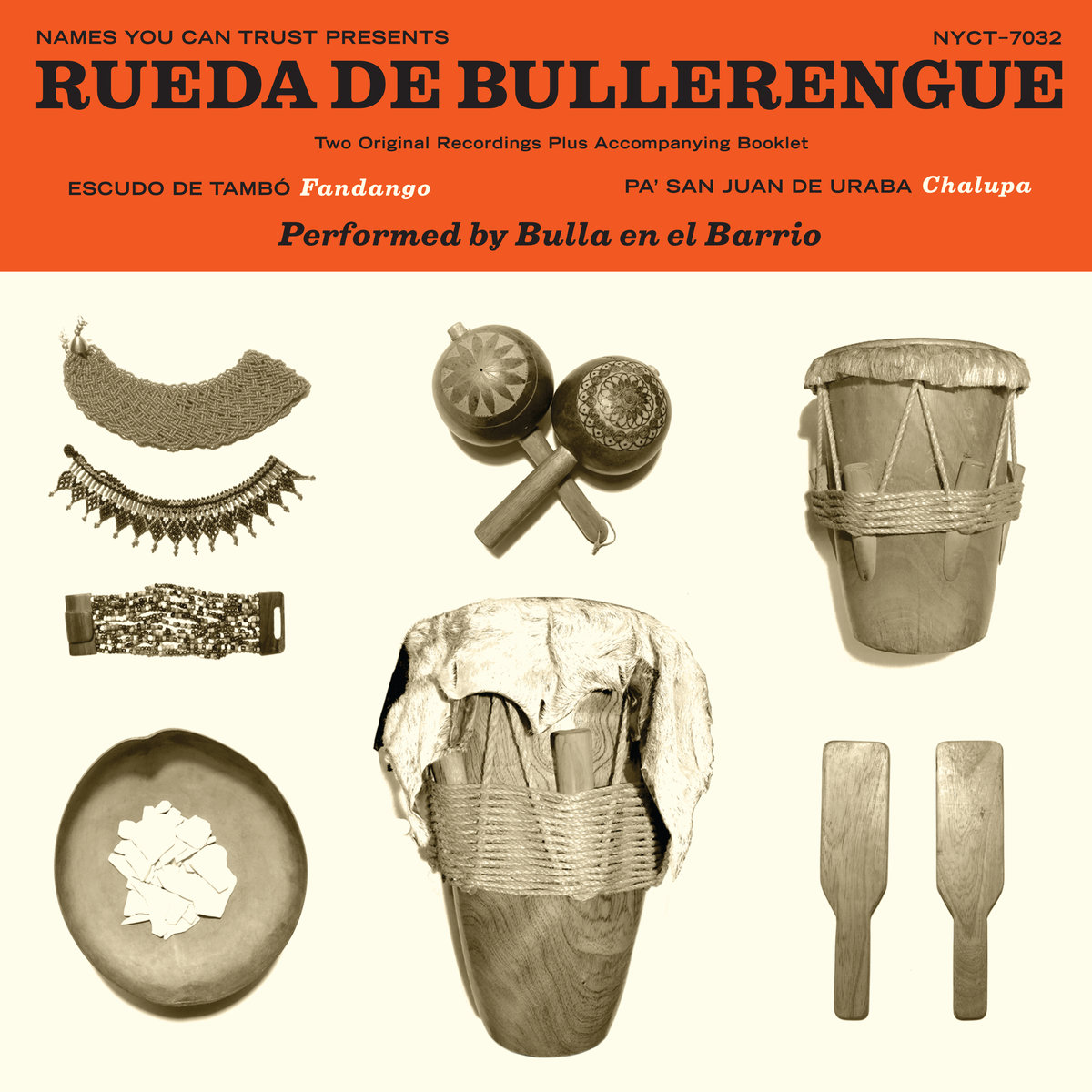The new 45 from Bulla en El Barrio features two original bullerengue compositions, a chalupa and a fandango, representing two of the three rhythms and dance styles that make up bullerengue, an Afro-Colombian traditional music from the Caribbean coast. The cover art, rendered in vintage ethnomusicological LP style, depicts the instruments and accessories of bullerengue in isolation, but press play (or, even better, put a needle to the record) and you are overwhelmed with a distinct sound, feeling, and even sense of time and place.
"El bullerengue es más que música. Es un estilo de vida" [Bullerengue is more than music, it's a lifestyle], Carolina Oliveros, cantadora of Bulla en El Barrio told us last year, when we met to discuss the group for our program "Colombia in NYC." Bullerengue is part of a larger family of music known as bailes cantados--sung dances, and Carolina's riveting voice is the first thing you hear on side one, "Escudo de Tambor." From the first plaintive notes of her introduction, we are invited into the sonic world of bullerengue: powerful, relentless drumming, punctuated with high-pitched cries of encouragement, and resounding chorus vocals that answer the lead singer's supplications. "Escudo de Tambor," brings us into a scene, an energy, and a history.In bullerengue, as in many other styles of so-called traditional music around the world, there is room for new compositions, new innovations and stylistic changes, in fact, any good group must have original compositions. One of powerful facts about this record is that these songs are original compositions, made and performed in New York by Colombians who did not grow up in the tradition of bullerengue, but have dedicated themselves to transmitting the feelings, the emotions, the sounds, sights and smells of this culture. In "Pa' San Juan de Uraba," written by drummer Camilo Rodriguez, Carolina cites important places in the world of bullerengue: "Desde Necoclí/ pa' Maria La Baja/de Puerto Escondido/pa' San Juan de Uraba," connecting the New York- based group with the physical, spatial lineage of the genre. Carolina makes the connection even more personal with a tribute to veteran bullerengue composer Emilsen Pacheco, one of her teachers, who lives in San Juan De Urabá. He had immortalized Carolina (whose given name is Diana Herrera) in his song "Linda Barranquillera." This completely blew her away:
"Que un maestro te componga un bullerengue, es una vaina ahí como loca. Pues ‘pa uno es una vaina muy grande, super bonito. Entonces bueno. Yo creo que yo me sentí endeudada con el. Es un regalo que no tiene precio..."
[It's a crazy thing, that a master should compose a bullerengue for you! It's a really big deal, really amazing. It's a gift that has no price. So, I felt indebted to him.] So, Carolina included a shout-out to Pacheco in the lyrics of "Pa' San Juan De Urabá," "Simply to mention him, so he knows that he's present."
As you might guess from Pacheco's song, Carolina is from Barranquilla, further north on the Colombian coast than the regions that are home to bullerengue. She began her musical life as a singer in a metal band, then studied classical music at the university, where she also first performed folkloric music. But when she witnessed bullerengue at a festival, she fell in love, and dedicated herself to learning the style from the people who lived and breathed the music:
"A nadie le enseña uno el bullerengue o sea. Allá en la universidad. Uno tiene que ir a donde los que hace una cosa de verdad meterte en los pueblitos, dormir en el suelo, tomar agua cruda, enfermarte del estómago. Uno tiene que vivir esa experiencia. Yo fui allá con junto con mi otra amiga... fue que no las pasamos llorando. Pero era como un llanto de “ah” como una cosa que no sabíamos explicar porque llorabamos."
["Nobody can be taught bullerengue, as such, in the university. One has to go where the thing is really done, go to the little villages, sleep on the ground, drink unfiltered water, get sick to the stomach. One has to have lived this experience. I went there with a friend. We spent the entire festival crying, but a type of crying where we couldn't explain why we were crying."]
When Carolina moved to New York, she found herself in a community of Colombians as dedicated as she was to digging deeper into their Afro-Colombian cultural roots. The group has undertaken study trips back to Colombia, learning with the masters and immersing themselves in the fountain of culture from which their music springs. But, New York City is home: From sessions in the park, to a host of public performances, Bulla en El Barrio quickly became a staple here. With this record, Rueda de Bullerengue, out June 9 on Names You Can Trust, the group is also sending a message back to Colombia, and to the world: with this recording, this captured sonic instant, they are documenting an important moment in the history of bullerengue. Bulla en El Barrio proves that bullerengue has traveled far without losing its roots, and can travel further still.









